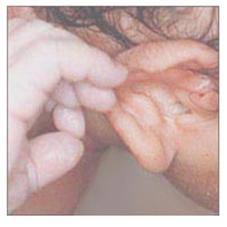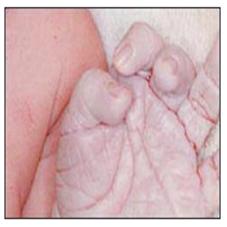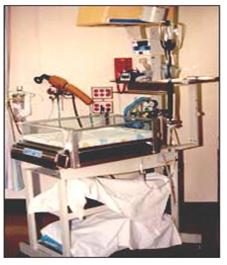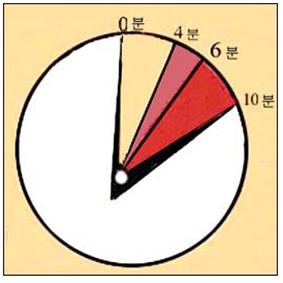신생아 질식(신생아 가사), Neonatal asphyxia
신생아 질식(신생아 가사)의 개요
- 분만 전, 분만 중, 분만 직후, 또는 그 이후 태아난 신생아가 얼마동안 무슨 원인으로든 산소를 충분히 공급받지 못할 때 생기는 병을 신생아 질식, 또는 신생아 가사라고 한다.
- 신생아가 심하게 질식될 때 질식 중증도에 따라 뇌, 심장, 폐, 위장, 신장 등 인간 생명 기본 유지에 꼭 필요로 하는 신체의 각계통의 기관과 조직이 일시적으로, 또 영구적으로 손상될 수 있다.
- 신생아 질식의 원인은 여러 가지가 있다.
- 여기서 출산 전·중 원인과 출산 후 원인으로 크게 분류해 본다. (질식 참조)
신생아 질식의 원인
1. 출산 전·중 태아 질식의 원인
- 분만부가 전신 마취를 받으면서 분만할 때 분만부가 산소 공급을 충분히 받지 못할 때 태아도 산소 공급을 충분히 받지 못해 태아가 질식될 수 있다.
- 심한 심장병을 앓는 분만부의 태아
- 척수 마취를 받으면서 분만하는 동안 분만부의 혈압이 비정상적으로 갑자기 떨어질 때
- 자궁 속 태아에게 피를 공급하는 분만부의 골반강 내 동맥이 임신 자궁체로 꼭 눌려 모체의 피가 태아에게 충분히 공급되지 않고 그로 인해 태아에게 산소의 공급이 충분히 되지 않을 때.
- 빨리 분만할 수 있게 자궁 수축제를 분만부에게 주어 분만부의 피가 태아에게 충분히 공급되지 못할 때.
- 탯줄 매듭으로 태반에서 태아에게 피가 충분히 공급되지 않을 때
- 그 외 원인으로 태아질식이 생길 수 있다.
2. 출산 후 신생아 질식의 원인
- 신생아의 핏속에 있는 적혈구가 심하게 용혈되거나 심한 내출혈이나 외출혈이 갓 태어난 신생아에게 생겨 심한 빈혈이 신생아에게 생길 때
- 갓 태어난 신생아가 패혈증이나 뇌막염 등 감염병으로 쇼크에 빠지든지, 심한 빈혈이 생길 때, 또는 두개강 내 출혈이 생겼을 때
- 뇌 손상이 생기거나 중추신경계 기능에 유해한 약물 치료를 받은 후 숨을 제대로 쉬지 못할 때
- 심한 선천성 심장병으로 산소 결핍증이 생길 때
- 갓 태어난 신생아가 양수, 태변, 또는 모체의 대변 등을 기도 속으로 흡인하여 기도 속이 막힐 때
- 그 외 원인으로
신생아 질식의 증상 징후
- 태아 질식이나 신생아 질식은 비교적 흔히 볼 수 있는 병이다.
- 태아 질식은 신생아 질식으로 이어지는 것이 보통이다.
- 질식의 원인, 중증도, 합병증의 유무 등에 따라 증상 징후가 다르다.
- 분만 전이나 분만 중 태아가 모체로부터 피를 충분히 공급받지 못해 태아의 혈액 내 산소 농도가 비정상적으로 낮을 때 태아가 질식될 수 있다.
- 자궁 속에서 심하게 질식된 태아는 양수 속에다 태변을 눌 수 있다.
- 태아의 심장박동이 비정상적으로 빠르거나 늦어질 수 있고, 불규칙할 수 있다.
- 때로는 태아가 질식으로 자궁 내에서 사망할 수 있다.
- 출산 직후 신생아들이나 그 후 신생아들이 산소 공급을 충분히 받지 못할 때도 질식될 수 있다.
- 산소 결핍의 정도에 따라 질식의 중증도가 경미할 수도 있고 심할 수도 있고 사망할 수도 있다.
심한 신생아 질식의 전형적인 증상 징후
- 처음에는 피부가 창백해지거나 파래지고 잘 울지 못한다.
- 몸과 팔다리에 힘이 없어 몸이 축 늘어진다.
- 심장 박동수가 비정상적으로 빨라지거나 늦어질 수 있다.
- 숨을 정상보다 빨리 쉬거나 느리게 쉴 수 있고 소리 내면서 신음할 수 있다.
- 적절히 응급 치료를 해주지 않으면 전신 발작을 일으키고, 또 더 심하면 사망한다.

사진 209. 갓 태어난 신생아의 손에 생긴 선단 청색증.
제왕 절개수술 분만으로 태어난 신생아의 손에 생긴 선단 청색증.
Copyright ⓒ 2011 John Sangwon Lee,MD., FAAP

사진 210. 갓 태어난 신생아의 손에 생긴 선단 청색증.
제왕 절개수술 분만으로 태어난 아기의 손에 생긴 선단 청색증.
Copyright ⓒ 2011 John Sangwon Lee, MD., FAAP
신생아 질식의 진단

사진 208.신생아 질식을 예방하고 질식 됐을 때 치료에 쓸 수 있는 의료기구 및 산소 그리고 진보적 심폐 소생술을 즉시 시작 할 수 있는 약물·산소·이런 기구들이 준비되어 있다.
Copyright ⓒ 2011 John Sangwon Lee, MD., FAAP

그림 211. 신생아나 신생아기 이후 소아청소년들, 또는 성인들이 질식됐을 때 소생시키는 데는 소요될 시간이 극히 제한됐다. 0-4분 내 소생시켜야 살 가능성이 있다.
Copyright ⓒ 2011 John Sangwon Lee, MD., FAAP
- 병력, 증상 징후, 진찰소견 등을 종합해서 신생아가 질식됐다고 의심되면 혈중 산소농도 등을 측정해서 질식 중증도가 어느 정도인지 알아볼 수 있다.
- 요즘 분만 중 태아 심장 박동 상태를 태아 모니터로 계속 관찰하면서 분만하는 것이 보통이다.
- 태아 모니터로 태아 심장 박동이 정상적으로 뛰는지, 비정상적으로 뛰는지 빠르게 뛰는지 느리게 뛰는지 규칙적으로 뛰는지 불규칙으로 뛰는지 자세히 정확히 알아볼 수 있다.
- 그래서 분만 중 태아가 질식 상태에 있는지 건강한지 쉽게 알아볼 수 있다.
- 자궁 속에서 태변을 누면 태아가 질식 상태에 있다는 징조이다.
- 태어났을 때 아기의 아프가르 총 점수를 채점해 보면 생후 1분, 5분, 10분에 갓 태어난 신생아의 전반적인 건강 상태의 정도가 어떠했었는지도, 갓 태어난 신생아가 질식됐었는지, 질식되지 않았었는지 타각적으로 알 수 있다.
- [부모도 반의사가 되어야 한다-소아가정간호백과]-제6권 신생아 성장 발육 양호 질병-아프가(아프가르) 점수 참조.
- 갓 태어난 신생아가 질식되면 그 질식 상태를 응급으로 치료 해 주는 것도 중요하지만 무엇 때문에 질식되었는지 그 원인을 즉시 알아내거나, 적어도 추정해 원인을 동시 치료해 주어야 한다.
- 산소 결핍이나 기도 내 이물 등으로 산소 공급을 충분히 받지 못할 때 뇌 손상이 생기거나 사망할 수 있다.
- 기도 내 이물로 막힌 기도를 열어 기도 확보를 해 주고 숨을 정상적으로 쉬게 할 수 있는 시간은 극히 제한되어 있다.
- 기도가 막혀 숨을 쉬지 못해 산소 결핍이 생길 때, 0~4분 이내에 산소를 정상적으로 공급하면 뇌손상이 생길 가능성은 적으나 4~6분 이상 지나면 뇌 손상이 생길 가능성이 많고 6~10분 이상 지나면 뇌손상이 영구적으로 생길 수 있다.
- 갓 태어난 신생아가 질식되지 않게 예방적 치료를 하는 것도 중요하지만 질식 상태에 빠지려고 하거나 질식 상태에 빠져 있으면 즉시 적절히 치료하는 것도 중요하다.
신생아 질식의 치료
- 태아 질식이나 신생아 질식 원인은 앞서 열거한 것 이외 더 많이 있다.
- 모든 임산부는 안전하게 임신해서 분만할 때까지 의사의 지시에 따라 임산부가 지켜야 할 모든 임신 중 안전사항을 잘 지켜야 한다.
- 안전 분만을 위한 분만 의료시설이 제대로 갖추어지고, 태아와 신생아 질식을 적절히 예방할 수 있고, 치료할 수 있는 의료진이 있는 종합 병원 분만실에서 안전하게 분만하는 것이 신생아 질식을 예방하는 데 가장 좋은 열쇠이다.
태아 질식이나 신생아 질식이 생길 때 즉시 적절히 치료할 수 있는 방법
- 병원에서도 태아나 신생아가 질식되지 않게 예방하기 위해 만반의 준비도 미리 하고 질식예방에 전력을 다 한다.
- 신생아가 질식됐을 때는 그 원인에 관계없이 신생아에게 100% 산소호흡 치료를 즉시 시작해 정상 혈중 산소 농도를 유지시키고 숨을 정상적으로 쉬게 하는 질식 응급 처치 및 진보적 생명유지치료를 한다.
- 입, 비강, 인두강, 후두 기관 속에 괸 양수, 점액, 태변, 피 등을 흡입구나 흡입기로 흡인해서 기도 속을 열어 기도를 확보해 주고 숨을 정상적으로 쉬게 즉시 처치한다.
- 원인이 무엇인지 알아보고
- 필요한 약물로 치료한다.
- 산소호흡 치료를 시키고 기도를 열어 준 후에도 신생아가 질식 상태에 있으면 질식 중증도에 따라 인공호흡, 심장마사지 또는 신생아 진보적 심폐 소생술 치료를 한다.
- 그래도 심장이 잘 뛰지 않을 때에는 에피네프린 등 약물 치료도 한다.
Neonatal asphyxia
Overview of Neonatal Choking
• Neonatal asphyxia, or neonatal housework, is a condition that occurs before, during, immediately after, or after delivery when a newborn baby does not receive adequate oxygen for some reason.
• When a newborn baby is severely choked, organs and tissues of various body systems essential for basic human life such as brain, heart, lung, stomach, and kidney may be temporarily or permanently damaged depending on the severity of asphyxiation.
• There are several causes of neonatal asphyxia.
• Here, we will broadly classify causes before and during childbirth and causes after childbirth. (see Choking)
Causes of suffocation in newborns
1. Causes of fetal asphyxiation before and during childbirth
• When the delivery woman delivers while under general anesthesia If the delivery woman does not receive adequate oxygen supply, the fetus may also suffocate due to insufficient oxygen supply.
• Fetuses in deliveries with severe heart disease
• Abnormally sudden drop in blood pressure during delivery while receiving spinal anesthesia
• When the artery in the pelvic cavity of the delivery woman, which supplies blood to the fetus in the womb, is compressed with the uterine body of the pregnant woman, the mother’s blood is not supplied enough to the fetus, and as a result, oxygen is not supplied to the fetus.
• When there is insufficient blood supply to the fetus by giving the delivery woman a uterine contraceptive to allow for faster delivery.
• When there is not enough blood from the placenta to the fetus due to an umbilical cord knot. • Other causes can cause fetal asphyxiation.
2. Causes of neonatal asphyxia after childbirth
• When the newborn baby develops severe anemia due to excessive hemolysis of red blood cells in the newborn’s blood or severe internal or external bleeding.
• When a newborn baby falls into shock due to an infectious disease such as sepsis or meningitis, severe anemia, or intracranial hemorrhage
• When you have trouble breathing after having a brain injury or taking medications that are harmful to your central nervous system function.
• When severe congenital heart disease causes oxygen starvation
• When a newborn baby sucks amniotic fluid, meconium, or mother’s feces into the airway and the airway is blocked.
• For other reasons
Signs, symptoms of neonatal asphyxia
• Fetal asphyxiation or neonatal asphyxiation is a relatively common disease.
• Fetal asphyxiation usually leads to neonatal asphyxia.
• Symptoms vary depending on the cause, severity, and presence or absence of complications.
• If the fetus does not receive enough blood from the mother before or during delivery, and the oxygen level in the fetus’s blood is abnormally low, the fetus may be suffocated.
• A fetus that is severely choked in the womb may have meconium in the amniotic fluid.
• The fetus’s heartbeat may be abnormally fast, slow, or irregular.
• Sometimes the fetus can die in the womb from asphyxiation.
• Asphyxiation can also occur in newborns shortly after birth and later in newborns who do not receive adequate oxygen.
• Depending on the degree of oxygen deprivation, suffocation may be mild or severe and may result in death.
Typical symptoms, signs of severe neonatal asphyxia
• At first, the skin becomes pale or blue and does not cry well.
• There is no strength in the body and limbs, making the body droopy.
• Your heart rate may be abnormally fast or slow.
• You may breathe faster or slower than normal and may moan loudly.
• Without proper first aid treatment, it can cause generalized seizures and, in worse cases, death.

Photo 209. Acromial cyanosis in the hands of a newborn baby. Axonal cyanosis in the hands of newborns born by cesarean section. Copyright ⓒ 2011 John Sangwon Lee, MD., FAAP

Photo 210. Acromial cyanosis in the hands of a newborn baby. Anterior cyanosis of the hands of babies born by cesarean section. Copyright ⓒ 2011 John Sangwon Lee, MD., FAAP
Diagnosis of neonatal asphyxia

Photo 208. Medical equipment and oxygen that can be used to prevent suffocation of newborn babies and to treat suffocation in case of suffocation and drugs, oxygen, etc. that can immediately start progressive CPR are available. Copyright ⓒ 2011 John Sangwon Lee, MD., FAAP

Figure 211. When newborns or post-neonatal children, or adults, are choked, the time taken to resuscitate is extremely limited. There is a possibility of survival if revived within 0-4 minutes. Copyright ⓒ 2011 John Sangwon Lee, MD., FAAP
• If a newborn is suspected of suffocation by combining the medical history, symptom signs, and examination findings, the degree of asphyxiation severity can be determined by measuring blood oxygen concentration.
• It is common these days to deliver while continuing to monitor the fetal heartbeat on a fetal monitor during labor.
• The fetal monitor can accurately determine whether the fetal heart is beating normally, abnormally, fast, slow, regular or irregular.
• So it is easy to tell if the fetus is choking or healthy during labor.
• Having meconium in the womb is a sign that the fetus is choking.
• Scoring a baby’s Afgar total score at birth indicates how well the overall health of the newborn was at 1, 5, and 10 minutes of life, and whether the newborn was choked or not. It can be seen objectively that
•www.drleepediatrics.com – Volume 6 Newborn Growth and Developmental Good Disease – Afgar (Afgar) score.
• When a newborn baby suffocates, it is important to treat the asphyxiation condition in an emergency, but the cause of the suffocation must be immediately identified or at least estimated and treated at the same time.
• When oxygen is not supplied enough due to lack of oxygen or a foreign body in the airways, brain damage or death may occur.
• The time to open the airway blocked by a foreign object in the airway to secure the airway and to breathe normally is extremely limited.
• When oxygen deficiency occurs due to obstruction of the airway, if oxygen is supplied normally within 0 to 4 minutes, brain damage is less likely, but after 4 to 6 minutes or more, brain damage is more likely and more than 6 to 10 minutes Over time, brain damage can become permanent.
• While it is important to provide preventive treatment to prevent suffocation in newborns, it is also important to treat them promptly and appropriately if they are about to become choking or are choking.
Treatment of neonatal asphyxia
• There are many more causes of fetal or neonatal asphyxiation than those listed above.
• All pregnant women should follow the instructions of their doctor and follow all safety precautions during pregnancy until they get pregnant safely and give birth.
• Safe delivery in the delivery room of a general hospital with adequate delivery facilities for safe delivery, adequate prevention and treatment of fetal and neonatal suffocation, is the best key to preventing neonatal asphyxia.
Immediate and appropriate treatment for fetal or neonatal asphyxia
• To prevent suffocation of the fetus or newborn even in the hospital, prepare everything in advance and do everything possible to prevent suffocation.
• When a newborn suffocates, regardless of the cause, immediately start 100% oxygen respiration therapy for the newborn, maintain normal blood oxygen concentration, and provide choking first aid and progressive life-sustaining treatment that allows them to breathe normally. • Aspirate amniotic fluid, mucus, meconium, blood, etc. from the mouth, nasal cavity, pharynx, and larynx with an inhaler or inhaler, open the airway to secure the airway, and take immediate measures so that you can breathe normally.
• Find out what the cause is
• Treat with necessary medications.
• If the newborn remains asphyxiated after oxygen respiration therapy and airway opening, artificial respiration, cardiac massage, or neonatal progressive cardiopulmonary resuscitation (CPR) should be performed depending on the severity of asphyxiation.
• If the heart still does not beat well, medications such as epinephrine are also given.
출처 및 참조 문헌 Sources and references
- NelsonTextbook of Pediatrics 22ND Ed
- The Harriet Lane Handbook 22ND Ed
- Growth and development of the children
- Red Book 32nd Ed 2021-2024
- Neonatal Resuscitation, American Academy Pediatrics
- 인공호흡과 심장마사지(심폐 소생술),
- 질식(가사),
- 응급 신생아 심폐 소생술 Neonatal cardiopulmonary resuscitation 참조
- www.drleepediatrics.com 제1권 소아청소년 응급 의료
- www.drleepediatrics.com 제2권 소아청소년 예방
- www.drleepediatrics.com 제3권 소아청소년 성장 발육 육아
- www.drleepediatrics.com 제4권 모유,모유수유, 이유
- www.drleepediatrics.com 제5권 인공영양, 우유, 이유식, 비타민, 미네랄, 단백질, 탄수화물, 지방
- www.drleepediatrics.com 제6권 신생아 성장 발육 육아 질병
- www.drleepediatrics.com제7권 소아청소년 감염병
- www.drleepediatrics.com제8권 소아청소년 호흡기 질환
- www.drleepediatrics.com제9권 소아청소년 소화기 질환
- www.drleepediatrics.com제10권. 소아청소년 신장 비뇨 생식기 질환
- www.drleepediatrics.com제11권. 소아청소년 심장 혈관계 질환
- www.drleepediatrics.com제12권. 소아청소년 신경 정신 질환, 행동 수면 문제
- www.drleepediatrics.com제13권. 소아청소년 혈액, 림프, 종양 질환
- www.drleepediatrics.com제14권. 소아청소년 내분비, 유전, 염색체, 대사, 희귀병
- www.drleepediatrics.com제15권. 소아청소년 알레르기, 자가 면역질환
- www.drleepediatrics.com제16권. 소아청소년 정형외과 질환
- www.drleepediatrics.com제17권. 소아청소년 피부 질환
- www.drleepediatrics.com제18권. 소아청소년 이비인후(귀 코 인두 후두) 질환
- www.drleepediatrics.com제19권. 소아청소년 안과 (눈)질환
- www.drleepediatrics.com 제20권 소아청소년 이 (치아)질환
- www.drleepediatrics.com 제21권 소아청소년 가정 학교 간호
- www.drleepediatrics.com 제22권 아들 딸 이렇게 사랑해 키우세요
- www.drleepediatrics.com 제23권 사춘기 아이들의 성장 발육 질병
- www.drleepediatrics.com 제24권 소아청소년 성교육
- www.drleepediatrics.com 제25권 임신, 분만, 출산, 신생아 돌보기
- Red book 29th-31st edition 2021
- Nelson Text Book of Pediatrics 19th- 21st Edition
- The Johns Hopkins Hospital, The Harriet Lane Handbook, 22nd edition
- 응급환자관리 정담미디어
- Pediatric Nutritional Handbook American Academy of Pediatrics
- 소아가정간호백과–부모도 반의사가 되어야 한다, 이상원 저
- The pregnancy Bible. By Joan stone, MD. Keith Eddleman, MD
- Neonatology Jeffrey J. Pomerance, C. Joan Richardson
- Preparation for Birth. Beverly Savage and Dianna Smith
- 임신에서 신생아 돌보기까지. 이상원
- Breastfeeding. by Ruth Lawrence and Robert Lawrence
- Sources and references on Growth, Development, Cares, and Diseases of Newborn Infants
- Emergency Medical Service for Children, By Ross Lab. May 1989. p.10
- Emergency care, Harvey Grant and Robert Murray
- Emergency Care Transportation of Sick and Injured American Academy of Orthopaedic Surgeons
- Emergency Pediatrics A Guide to Ambulatory Care, Roger M. Barkin, Peter Rosen
- Quick Reference To Pediatric Emergencies, Delmer J. Pascoe, M.D., Moses Grossman, M.D. with 26 contributors
- Neonatal resuscitation Ameican academy of pediatrics
- Pediatric Nutritional Handbook American Academy of Pediatrics
- Pediatric Resuscitation Pediatric Clinics of North America, Stephen M. Schexnayder, M.D.
-
Pediatric Critical Care, Pediatric Clinics of North America, James P. Orlowski, M.D.
-
Preparation for Birth. Beverly Savage and Dianna Smith
-
Infectious disease of children, Saul Krugman, Samuel L Katz, Ann A.
- 제4권 모유, 모유수유, 이유 참조문헌 및 출처
- 제5권 인공영양, 우유, 이유, 비타민, 단백질, 지방 탄수 화물 참조문헌 및 출처
- 제6권 신생아 성장발육 양호 질병 참조문헌 및 출처
- 소아과학 대한교과서
Copyright ⓒ 2014 John Sangwon Lee, MD., FAAP
“부모도 반의사가 되어야 한다”-내용은 여러분들의 의사로부터 얻은 정보와 진료를 대신할 수 없습니다.
“The information contained in this publication should not be used as a substitute for the medical care and advice of your doctor. There may be variations in treatment that your doctor may recommend based on individual facts and circumstances.
“Parental education is the best medicine.